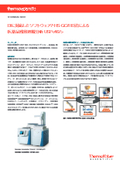[Case Study] Analysis of Residual Solvents in Pharmaceuticals for Data Integrity Compliance
Immediate start of residual solvent analysis in pharmaceuticals using the HS-GC/FID method with data integrity compliance.
Information has become increasingly diverse in recent years, and there is a growing demand for tools that can handle vast amounts of data accurately and conveniently. For example, analytical researchers may find it sufficient to obtain calibration curves and quantitative data from chromatograms and spectral information as chromatography data. However, it may be necessary to ensure that these data were obtained under conditions where the equipment operated correctly. Computerized systems used in the development and manufacturing of pharmaceuticals and medical devices must be properly developed, implemented, and operated, leaving evidence that proves there are no issues with the quality of the pharmaceuticals or medical devices, as well as their quality assurance. Computerized System Validation (CSV) is mandated by pharmaceutical regulations. Achieving Data Integrity (DI) requires essential support from software. This technical note outlines the overview of DI and the software functions required for DI, and introduces examples of residual solvent testing as specified in USP<467> using a headspace-specific autosampler and gas chromatograph that comply with DI.
basic information
For details, please contact us or refer to the PDF.
Price range
Delivery Time
Applications/Examples of results
For details, please contact us or refer to the PDF.
catalog(3)
Download All CatalogsRecommended products
Distributors
Thermo Fisher Scientific K.K., the Japanese subsidiary of Thermo Fisher Scientific Incorporated, is a sales company for comprehensive system analysis instruments, bio-related equipment, and research reagents. In Japan, it has bases in Yokohama, Tokyo, Osaka, Fukuoka, and Nagoya, handling various analytical instruments including mass spectrometers, various bio-related equipment, measuring instruments, medical devices, lab software, and research reagents.














































